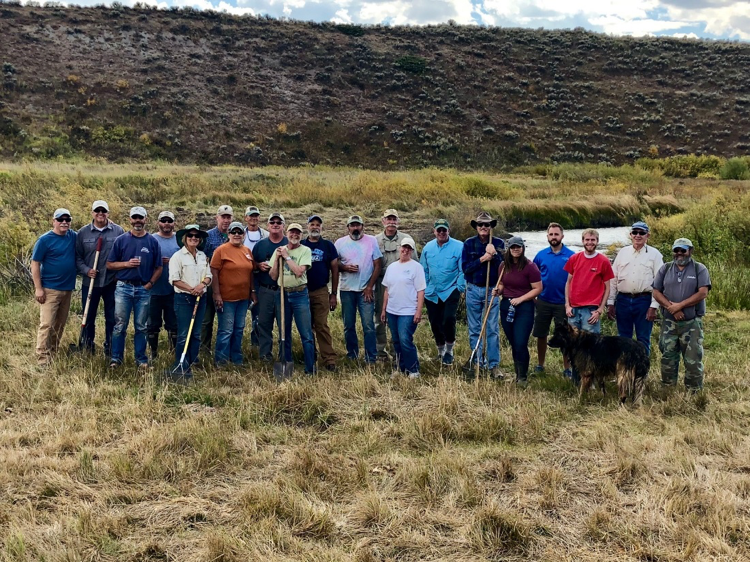
Monday, August 19, 2019
Contacts:
Leslie Steen, Snake River Headwaters Project Manager, Trout Unlimited, 307-699-1022, lsteen@tu.org
Lee Mabey, Forest Fisheries Biologist, Caribou-Targhee National Forest, 208-557-5784, lmabey@fs.fed.us
JACKSON, Wyoming –Trout Unlimited (TU) and the Caribou-Targhee National Forest (CTNF) announced today the Tincup Creek Stream Restoration Project’s third year of construction is underway. The project is a large-scale, multi-phased project initiated in 2017 to improve ecosystem function and habitat for cutthroat trout and other native fish species on 5 miles of degraded stream on CTNF lands. The project’s third year of construction implementation will run through September 30th, 2019. The final year of implementation is planned for 2020.
Partnerships have been a critical component of the project. The Tincup Creek Stream Restoration Project has received technical support and funding to date from the US Forest Service, Desert Fish Habitat Partnership, Jackson Hole One Fly, Jackson Hole TU chapter, National Forest Foundation, Snake River Cutthroats TU chapter, Southeast Idaho Wildlife Mitigation Fund, Star Valley TU Chapter, TU and Orvis Embrace-a-Stream Grant Program and Challenge, US Fish and Wildlife Service – Idaho, and the Western Native Trout Initiative. Additional in-kind support has been provided by Agrium, Bear Lakes Grazing Association, Caribou County, Idaho Department of Environmental Quality, Idaho Department of Fish and Game, Idaho Transportation Department, and OW Ranch.
“We are grateful for the all of the partners that have come together to restore native fisheries and stream health on Tincup Creek. It is a high priority conservation project that has brought together multiple agencies and groups, including ranchers, mines, fish biologists, conservation funders, and local community members. Many of our partners have committed support and volunteer hours to the project for multiple years, which has enabled us to keep chipping away at it at a manageable and cost-effective level” said Leslie Steen, TU Snake River Headwaters Project Manager. Together: Rebuilding Tincup, a project video highlighting its partnerships by Tight Line Media, is available to view on Vimeo.
The Tincup Creek project area is located above the junction of Highway 34 (Tincup Highway) and USFS Road #117 (Tincup / Bridge Creek Road), between Wayan, Idaho, and Freedom, Wyoming, in southeast Idaho. Tincup Creek within the project area has been impaired and degraded for more than 60 years, with the primary cause of the degradation linked to aerial spraying of willows in 1956. The loss of willows precipitated the destabilization of the stream and led to the loss of meander bends and stream length, steepened gradients, channel downcutting, and an unhealthy, disconnected floodplain and riparian zone.
The third phase of the project will continue to improve riparian conditions and habitat for Yellowstone cutthroat trout (Snake River cutthroat trout population), northern leatherside chub, boreal toad, western pearl shell mussels and pilose crayfish, which are all native species with special management emphasis, as well as native longnose and speckled dace, sculpin, reside shiners, and mountain suckers. Because of this native species assemblage, and Tincup Creek’s identification as a high-priority watershed in a multispecies conservation assessment of the Upper Snake River Basin, the project was named in 2017 as one of 10 Waters to Watch nationally by the National Fish Habitat Partnership. However, pre-project fish monitoring documented low densities of primarily adult trout, indicating poor habitat complexity for juvenile trout and smaller native fishes and the need for habitat restoration.
The project’s goals are to restore stream channel and floodplain processes and function to allow for all parts of the aquatic system to interact with each other. Restoration techniques include building floodplain benches, transplanting whole willows, reconnecting historic meanders, adding large woody debris, elevating riffles for floodplain reconnection, and reinforcing naturally-occurring beaver dams. These techniques will be carried out by heavy equipment operators experienced in stream restoration work, with year 3 of the project underway since the week of July 22nd, 2019 and expected to treat 1.2 miles of stream. In total, the project will restore 5 miles of aquatic habitat in the Tincup Creek watershed.
“The restoration and recovery is going great. It’s been great to see the stream connected to its floodplain again and the response of the western toads, ibis, cranes, many other waterfowl and of course the fish. A shout out to our many partners for helping push this forward” said Lee Mabey, Forest Fisheries Biologist for the Caribou-Targhee National Forest.
Volunteers from local TU chapters based in Idaho Falls, Star Valley, and Jackson Hole will assist with the restoration effort in 2019 as they did previously in 2017 and 2018. This year’s Tincup volunteer day is scheduled for Saturday, September 21st. Interested participants can contact the project contacts above for more information. In addition to providing volunteer support, all three TU chapters have contributed funding towards the project and two chapters (Star Valley and Jackson) have raised additional grassroots funding and prize money through the TU Orvis Embrace A Stream Challenge program, a week-long online competition and fundraising platform.
The Tincup Creek Stream Restoration Project is a project of TU’s Snake River Headwaters Home Rivers Initiative, an ambitious initiative to restore and protect the headwaters of the Snake River and its fishery, together with a diverse group of community, landowner, and agency partners.
About Trout Unlimited
Today,
Trout Unlimited is a national organization with more than 155,000 volunteers
organized into 400 chapters nationwide. These dedicated volunteers are paired with
a respected staff of organizers, lawyers, policy experts and scientists, who
work out of more than 30 offices. Our mission is to conserve, protect and
restore North America’s cold-water fisheries and their watersheds. Follow TU on
Facebook and Twitter, and follow our
blog for all the
latest information on trout and salmon conservation.
About the Caribou-Targhee National
Forest
One of the original purposes of theForest Service was to provide healthy watersheds and clean water. Forest Service lands are to be managed to provide the greatest good to the greatest numbers as we care for the land and serve the people.

